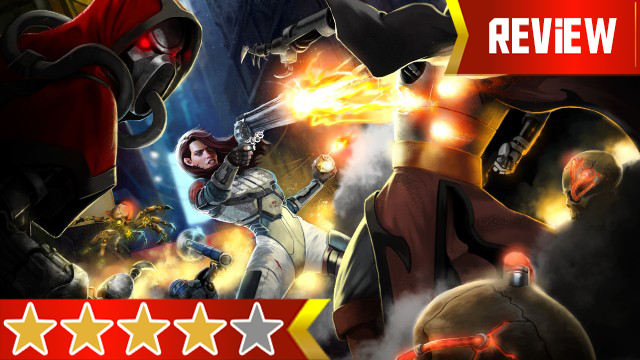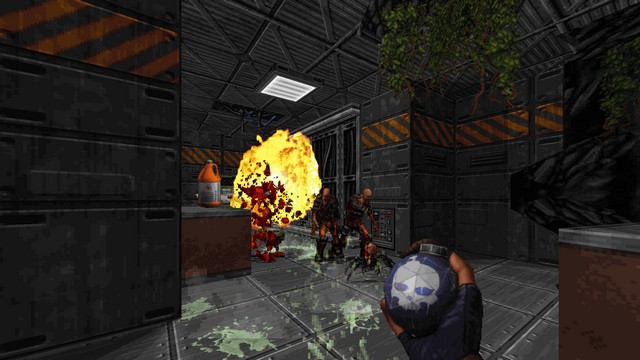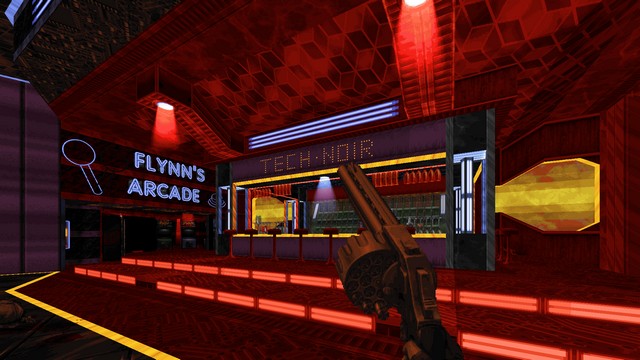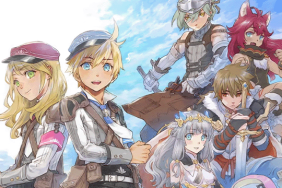Ion Fury debuted on PC late last year to acclaim; now it’s finally come to consoles. This throwback title channels the best of 1990s FPS design and was built using EDuke32, a modern fork of the Build engine that powered iconic titles like Duke Nukem 3D, Blood, and Shadow Warrior. It’s a love letter to the first-person shooters that made the genre a gaming staple, featuring fast-paced retro action paired with modern convenience.
It seems like Ion Fury would a perfect fit for the Nintendo Switch. Other FPS ports for the console, like Wolfenstein and Doom, have been plagued with muddy visuals as a result of the Switch’s low-end hardware. However, the demands of the enhanced Build fork can be too much for the Switch to handle at times, which makes playing this port a mixed bag.
Our initial review did an excellent job detailing the ins and outs of Ion Fury, so I’ll be concentrating on aspects specific to the Nintendo Switch port. If you’re curious about what Ion Fury is about and how it plays, take a look at our original review of the game on PC here.
Ion Fury Switch Review | A solid port
The Nintendo Switch port of Ion Fury contains all the content from the original PC release. Nothing has been cut or added, meaning that there’s nothing new to see here if you’ve played the game already on another platform. The gun-toting and violence remain intact. Nintendo hasn’t been big on censorship in a while, but it still trips me out when I see blood and cursing in a game on one of its platforms, considering the company’s stance in the 1990s.
With Ion Fury taking a more arcade-style approach to the first-person shooter genre, the game translates well to a controller. Like in other Build engine titles, Ion Fury has a bit of auto-aim by default, so playing on a controller doesn’t cost you a noticeable amount of precision. I found the fast-paced action to be just as controllable on the Joy-Cons or Pro Controller as I did with a mouse and keyboard.
ALSO: Predator: Hunting Grounds Review | One OK-looking motherf****r
The EDuke32 fork of the Build engine can be hardware intensive, but the Switch manages to display the visuals of Ion Fury without compromising fidelity. The game may have a throwback aesthetic, but the lighting and particle effects are impressive. The retro sprites and modern effects combine to give Ion Fury a visual style all its own, and it stands out amongst the flood of FPS games currently on the market.
Ion Fury Switch Review | Portholes
Of course, with the Switch, there has to be a bit of compromise. The most noticeable one for me came with the autosave function. The levels in Ion Fury are sprawling constructs that are at least 2-3 times as large as the typical Duke 3D map on average. Because of this, an autosave function is crucial, so you’re not losing 30-40 minutes of progress due to a cheap death. So, at several times throughout a level, the game will autosave, usually after getting a keycard, beating a large group of enemies, or progressing into the next segment of a level.
Unfortunately, each time Ion Fury autosaves, the Switch hangs for 5-10 seconds. It may not seem like a big deal, but you may hit an autosave point 5-6 times during a single level. This is especially frustrating on autosaves that are triggered by the player crossing a specific location on the map. Since you often have to backtrack, you might hit an autosave, find a key you need, and head back the same way and hit the save trigger again.
While the visuals aren’t downgraded for Switch, the same can’t be said about the framerate. Ion Fury runs at 30fps on handheld and docked mode, which takes a bit from a fast-paced game. Fortunately, the game doesn’t dip below 30fps too often, so things do stay pretty smooth. However, I do feel like this is definitely a title where a high framerate adds to the experience. Combat in Ion Fury just doesn’t feel as good at 30fps as it does at 60fps or higher.
Ion Fury Switch Review | Is this version right for you?
The Switch version of Ion Fury is worth a buy if that’s the only platform you own on which it’s available. The only advantage this edition has over others is that the Switch is portable. The lower framerate really works against this version of the game, and I feel like players will get more enjoyment by playing it on a platform with the horsepower to provide a steady 60fps.
However, if you’re unbothered by framerate, the Switch version of Ion Fury is just as complete content-wise as it is on any other platform. You won’t miss out on or gain any content on the Switch, and this is the only way to take the game on the go. If you’re set on picking up Ion Fury, your choice of platform really comes down to portability vs. framerate. If a handheld version of the game is essential, the Switch is the only console that can offer that feature. Otherwise, you’re best off picking the game up elsewhere.
-
Visual fidelity is intact.
-
Gameplay translates well to controller.
-
Only version of the game that's portable.
-
Game is locked to 30fps.













